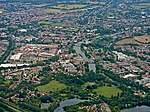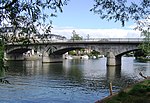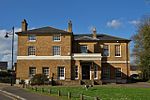Staines Boat Club

Staines Boat Club is a rowing club between Penton Hook Lock and Bell Weir Lock on the River Thames in England. The club was founded in 1869 when it was first listed in the Rowing Almanac as racing in that season. Its boathouse formally reopened in May 2022 after renovations. It is located next to the Hythe spur of the Thames Path in Egham Hythe, historically also known as Staines hythe, the last word meaning small harbour or river harbour. Staines has been the organising or support club for Staines Regatta since its inception and predates the rowing clubs on the Putney Embankment listed below. The club was founded in 1851 as an amateur rowing club while a manual-professional distinction applied to the sport, the same early year in the sport as the formal foundation of the club serving Windsor and Eton. The club has membership groups for different age groups.
Excerpt from the Wikipedia article Staines Boat Club (License: CC BY-SA 3.0, Authors, Images).Staines Boat Club
Riverside Drive, Borough of Runnymede
Geographical coordinates (GPS) Address Nearby Places Show on map
Geographical coordinates (GPS)
| Latitude | Longitude |
|---|---|
| N 51.431 ° | E -0.513 ° |
Address
Riverside Drive 30
TW18 3JN Borough of Runnymede
England, United Kingdom
Open on Google Maps








